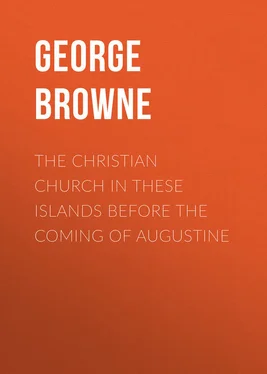George Browne - The Christian Church in These Islands before the Coming of Augustine
Здесь есть возможность читать онлайн «George Browne - The Christian Church in These Islands before the Coming of Augustine» — ознакомительный отрывок электронной книги совершенно бесплатно, а после прочтения отрывка купить полную версию. В некоторых случаях можно слушать аудио, скачать через торрент в формате fb2 и присутствует краткое содержание. Жанр: foreign_antique, foreign_prose, Историческая проза, на английском языке. Описание произведения, (предисловие) а так же отзывы посетителей доступны на портале библиотеки ЛибКат.
- Название:The Christian Church in These Islands before the Coming of Augustine
- Автор:
- Жанр:
- Год:неизвестен
- ISBN:нет данных
- Рейтинг книги:4 / 5. Голосов: 1
-
Избранное:Добавить в избранное
- Отзывы:
-
Ваша оценка:
- 80
- 1
- 2
- 3
- 4
- 5
The Christian Church in These Islands before the Coming of Augustine: краткое содержание, описание и аннотация
Предлагаем к чтению аннотацию, описание, краткое содержание или предисловие (зависит от того, что написал сам автор книги «The Christian Church in These Islands before the Coming of Augustine»). Если вы не нашли необходимую информацию о книге — напишите в комментариях, мы постараемся отыскать её.
The Christian Church in These Islands before the Coming of Augustine — читать онлайн ознакомительный отрывок
Ниже представлен текст книги, разбитый по страницам. Система сохранения места последней прочитанной страницы, позволяет с удобством читать онлайн бесплатно книгу «The Christian Church in These Islands before the Coming of Augustine», без необходимости каждый раз заново искать на чём Вы остановились. Поставьте закладку, и сможете в любой момент перейти на страницу, на которой закончили чтение.
Интервал:
Закладка:
Now we gather from the records that before the Jutes and the Angles and the Saxons came, and in their turn drove the Britons north and west, the religion of Christ had spread to all parts of the territory occupied by the Britons, that is, to the towns in all parts. It may very well have been that in the country parts there were many pagans left even to the last, perhaps in towns too. Putting the commencement of the driving out of the Britons at about the year 450 after Christ, we know that less than a hundred years before that time the pagans were so numerous in Gaul, that when Martin became Bishop of Tours, the pagans were everywhere, and to work for their conversion would have been sufficient work for him. As for the towns in Gaul, Hilary, the Bishop of Poitiers, was a leading official in that town, and only became a Christian in the year 350, when he was about thirty-five years of age. Martin of Tours, too, was born a heathen. We may be sure that in Britain, so remote from the centres of influence, and so inaccessible by reason of its insular position, that state of things continued to prevail a good deal longer than in the civilised parts of Gaul. We must not credit our British predecessors with anything like a universal knowledge and acceptance of Christianity.
It is not necessary to dwell on the familiar fact of the intermixture of the Romans and the Britons. In the more important towns there was much blending of the two races, and the luxurious arts of Rome produced their effect in softening the British spirit. The Briton gave up more than he gained in the mixed marriages, and it seems clear that the Romano-Britons who were left to face the barbarous Picts and Scots, and the hardy Angles and Saxons, were by comparison an enervated race. In the parts further remote from commercial and municipal centres, and from the military lines, it is probable that the invaders found much tougher work. It is only fair to the later Romano-Britons, to remember that all the flower of the youth of Britain had been carried away by one general and emperor after another, to fight the battles of Rome, or to support the claims of a usurper of the imperial purple, in Gaul and Spain and Italy; and when the imperial troops were finally withdrawn, the older men and the less hardy of the youths of Britain were left to cope with enemies who had baffled the Roman arms.
So much for the Britons. As for the Celts, we have sufficient evidence that the message of Christ was taken to them and welcomed by them in the later parts of the period ending with 450. During the years of the struggle between the Britons and their Teutonic invaders, say from 450 to 590, this Christianising went on among the Celts. About the end of that period it reached even to the furthest parts of the north, the parts which, in the early times of the Roman occupation, were probably held by descendants of the earlier race, and it more or less covered Ireland.
Thus the knowledge of the Christian faith had, before the English came, extended over the whole of that part of this island which the English invaders in their furthest reach ever occupied. It had covered – and it continued to cover, and has never ceased to cover – very much that they never even touched. To convert the early English to Christ, which was the task undertaken by Augustine, a very small part of it being accomplished by him or his mission from first to last, was to restore Christianity to those parts from which the English had driven it out. It was to remove the barrier of heathendom which the English invaders had formed between the Church universal and the Celtic and British church or churches. It proved in the end that the undertaking was much beyond the powers of the Italian missionaries; and then the earlier church stepped in from its confines in the West and did the work. It was so that the great English province of Northumbria – meaning vastly more than Northumberland, even all the land from Humber to Forth – was evangelized. It was so that the great English province of Mercia – the whole of the middle of the island – received the message of Christ. It was so that Christianity was given back to Essex and to us in London, by the labours of our Bishop Cedd, consecrated, as the crown of his long and faithful labours among our heathen predecessors, by the Celtic Bishop Finan of Lindisfarne. Cedd is an admirable example of the careful methods of the Celtic Church. He was not a Celt himself, he was an Angle. When the English branch of the Celtic Church, settled at Lindisfarne and evangelizing Northumbria, had succeeded in converting the son of the Mercian king, they sent him four priests as missionaries to his people, a people who were in large part Angles. Of these four priests, trained and sent by the Celtic Church for the conversion of the English, only one was a Celt; the other three, including Cedd, were themselves Angles. To send Anglian priests to convert Anglian people was indeed a wise and broad policy; and it was, as it deserved to be, eminently successful. It is a striking contradiction of the prevalent idea that the Celtic Church was isolated, narrow, bigoted; unable and unwilling to work with any but those of its own blood.
There are, then, these two main divisions before us, of the people who occupied these islands when the Romans came, and still occupied them when the English came, the Britons and the Celts 14 14 As has been already remarked, they are now generally described as the Brythonic and Goidelic branches of the Celtic race.
. We are not to suppose that this is nothing more than a mere dead piece of archaeology. It is a very living fact. A large proportion of those who are here to-day have to-day – possibly some of them not knowing it – kept alive the distinction between Briton and Celt. Every one who has spoken the name Mackenzie, or Macpherson, or any other Mac, has used the Celtic speech in its most characteristic feature. Every one who has spoken the name Price, that is, ap Rhys, or any other name formed with ap 15 15 Or with ab, as Bevan and Baddam, that is, ab Evan and ab Adam. Map and mab, ap and ab, stand for “son.”
, has taken the Briton’s side on this characteristic point. When you speak of Pen(maen)maur and the king Malcolm Ceanmor you are saying the same words; but in Penmaenmaur you take the Briton’s side, in speaking of Ceanmor you take the Celt’s. You will not find a better example than that which we owe to our dear Bede. The wall of Antonine abuts on the river Forth at Kinnell, a name which does not seem to have much to do with the end of a wall. But Bede tells us that the Picts of his day called it Penfahel, that is, head of the wall, “fahel” being only “wall” pronounced as some of our northern neighbours would pronounce it, the interesting people who say “fat” for “what.” He adds that the English, his own people, called it Penel, cutting the Penfahel short. The Britons called it Penguaul. The modern name Kinnell is the Celtic form of Penel.
Those being the people, and that the extent to which Christianity had in the end spread among them, how did Christianity find its way here?
The various suggestions that have from time to time been made, in the course of the early centuries, as to the introduction of Christianity to this island, were collected and commented on in a searching manner twenty-five years ago by two men of great learning and judgement. One of them was taken away from historical investigations, and from his canonry of St. Paul’s, to the laborious and absorbing work of a bishop. The other was lost to historical study by death. I need scarcely name Dr. Stubbs and Mr. Haddan. Their work has made darkness almost light.
We cannot wonder that the marvellous apostolic journeys and missionary work of St. Paul so vividly impressed the minds of the early Christian writers, that they attributed to him even more than he actually performed. Clement of Rome, of whom I suppose the great majority of students of the Scripture and of Church History believe that he actually knew St. Paul, says that Paul preached both in the West and in the East, and taught the whole world, even to the limits of the West. Chrysostom says that from Illyricum Paul went to the very ends of the earth. These are the strongest statements which can be advanced by those who think that St. Paul himself may have visited Britain. He may have reached Spain. There does not appear to be any evidence that he ever reached Gaul; still less Britain. One of the Greek historians, Eusebius, writing about 315, appears to say that Britain was Christianised by some of the disciples; and another, Theodoret, about 423, names the Britons among those who were persuaded to receive the laws of the Crucified, by “our fishermen and publicans.” This is evidence, and very interesting evidence, of the general belief that Britain was Christianised early in the history of Christianity, but it practically amounts to nothing more definite than that 16 16 St. Peter is now being claimed as one of the Apostles of Britain; but it is impossible to deal seriously with such a proposition. A pamphlet with this view was issued in 1893, by the Reverend W. Fleming, M. R. Cardinal Baronius, holding the view that St. Peter lived long in Rome, felt the difficulty which any one with the historic sense must feel, that St. Paul in his Epistle to the Romans makes no mention of St. Peter as being then in Rome, nor does the history in the last chapters of the Acts. The explanation given is that St. Peter, though permanently resident in Rome, was away from home on these occasions. As there is no trace of him in any known country at the time, Britain is taken as the place of his sojourn during some of the later years of St. Paul, probably as the country where traces of his sojourn were least likely to be found on record. Mr. Fleming quotes a passage from a book written in 1609 by the second “Vicar Apostolic of England and Scotland,” which is only too typical an example of a style of assertion and argument of which we might have hoped that we had seen the last. “I assure the indifferent reader, that St. Peter’s preaching to the ancient Britons, on the one side is affirmed both by Latins and Greeks, by ancient and modern, by foreign and domestic, by Catholic writers… by Protestant antiquaries…; and on the other side, denied by no one ancient writer, Greek or Latin, foreign or domestic, Catholic or other.”
.
Интервал:
Закладка:
Похожие книги на «The Christian Church in These Islands before the Coming of Augustine»
Представляем Вашему вниманию похожие книги на «The Christian Church in These Islands before the Coming of Augustine» списком для выбора. Мы отобрали схожую по названию и смыслу литературу в надежде предоставить читателям больше вариантов отыскать новые, интересные, ещё непрочитанные произведения.
Обсуждение, отзывы о книге «The Christian Church in These Islands before the Coming of Augustine» и просто собственные мнения читателей. Оставьте ваши комментарии, напишите, что Вы думаете о произведении, его смысле или главных героях. Укажите что конкретно понравилось, а что нет, и почему Вы так считаете.












